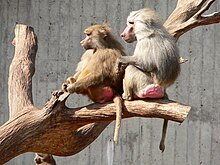
Back دودیسی جنسی در پستانداران ناانسان Persian Dimorfismo sexual em primatas Portuguese 非人類靈長類動物的性徵二形化 Chinese


Sexual dimorphism describes the morphological, physiological, and behavioral differences between males and females of the same species. Most primates are sexually dimorphic for different biological characteristics, such as body size, canine tooth size, craniofacial structure, skeletal dimensions, pelage color and markings, and vocalization.[1] However, such sex differences are primarily limited to the anthropoid primates; most of the strepsirrhine primates (lemurs and lorises) and tarsiers are monomorphic.[2]
Sexual dimorphism can manifest itself in many different forms. In male and female primates there are obvious physical difference such as body size or canine size. Dimorphism can also be seen in skeletal features such as the shape of the pelvis or the robustness of the skeleton.[3] There are two mating systems in the sexual selection of primates.
- ^ Flores, D.; Casinos, A. (2011). "Cranial ontogeny and sexual dimorphism in two New World monkeys: Alouatta caraya (Atelidae) and Cebus apella (Cebidae)]". Journal of Morphology. 272: 744–757. doi:10.1002/jmor.10947. hdl:11336/69038.
- ^ Plavcan, J. M. (2001). "Sexual dimorphism in primate evolution". American Journal of Physical Anthropology. 116 (S33): 25–53. doi:10.1002/ajpa.10011. ISSN 0002-9483. PMID 11786990. S2CID 31722173.
- ^ The differences between the sexes. Short, R. V. (Roger Valentine), 1930-, Balaban, E. (Evan), International Conference on Comparative Physiology (11th : 1992 : Crans, Switzerland). Cambridge: Cambridge University Press. 1994. ISBN 0-521-44411-X. OCLC 28708379.
{{cite book}}: CS1 maint: others (link)